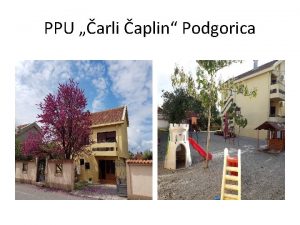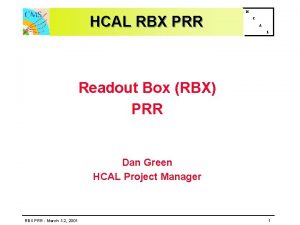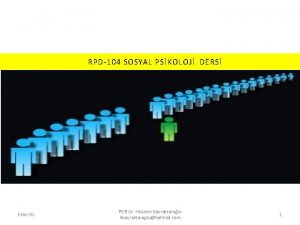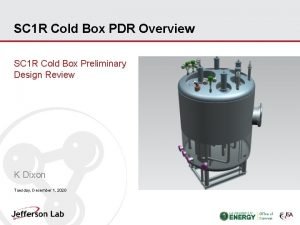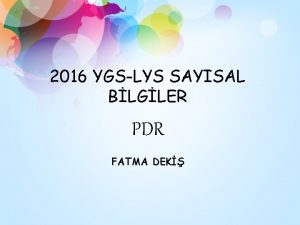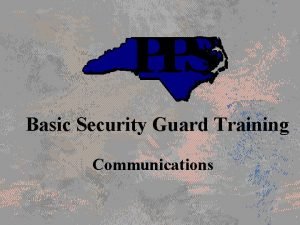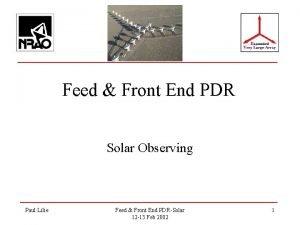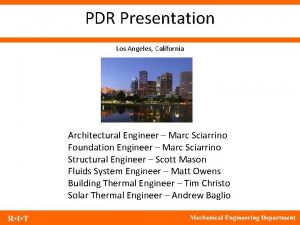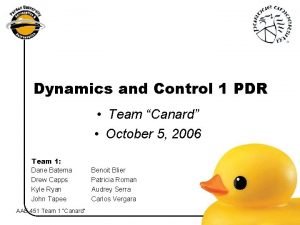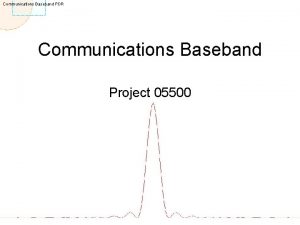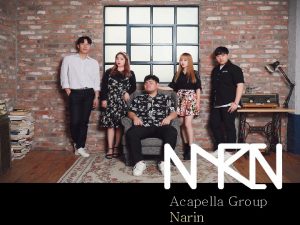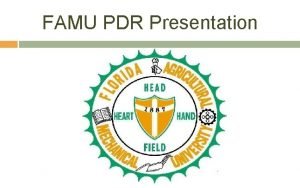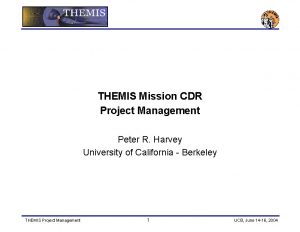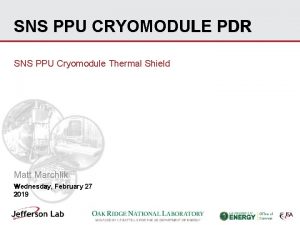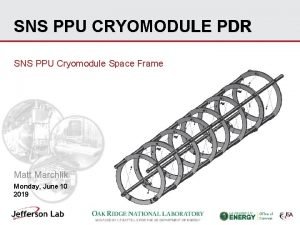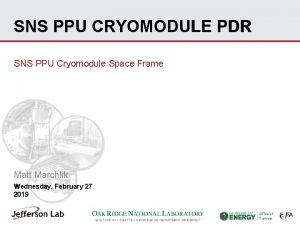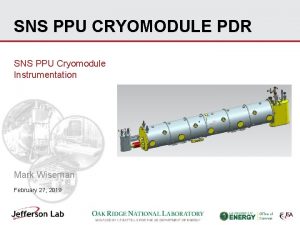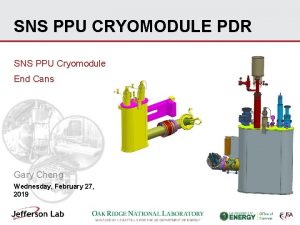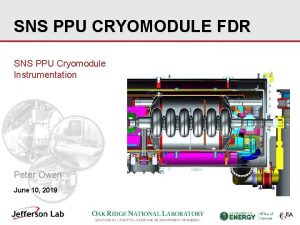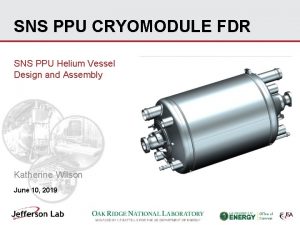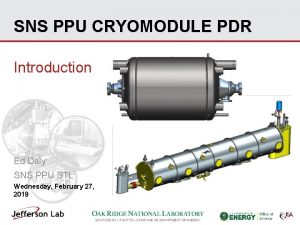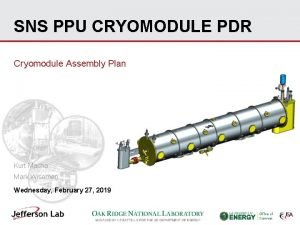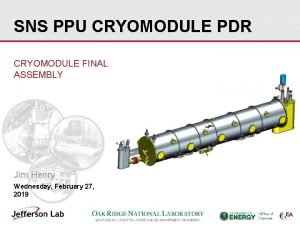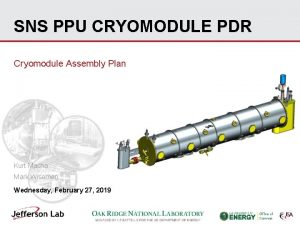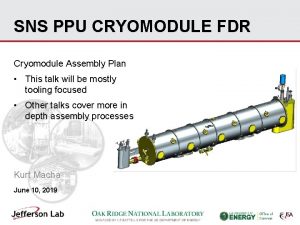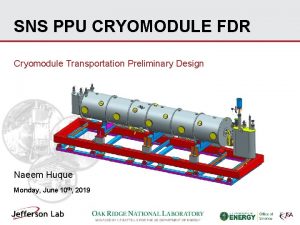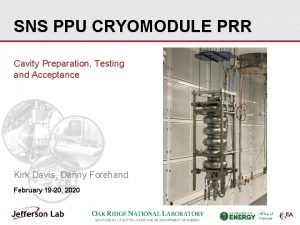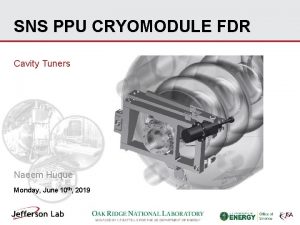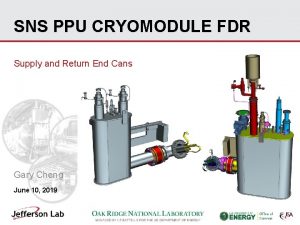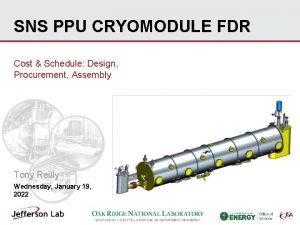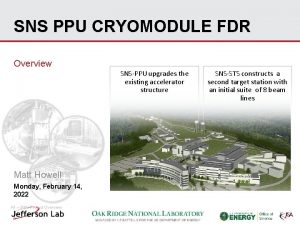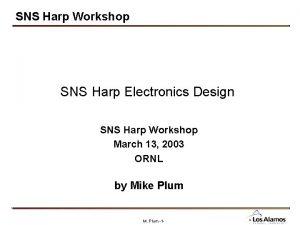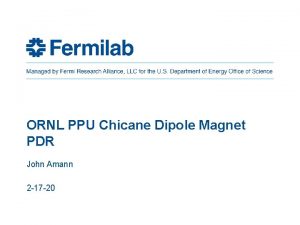SNS PPU CRYOMODULE PDR SNS PPU Cryomodule Thermal






















- Slides: 22

SNS PPU CRYOMODULE PDR SNS PPU Cryomodule Thermal Shield & MLI Matt Marchlik Monday, June 10 2019

Outline • Requirements • Design • Procurement • Response to PDR Recommendations and Comments • Remaining Tasks • Summary 2

Requirements Thermal Shield -Provide 50 K thermal radiation shielding to the cold mass -Allow for thermal contraction from 300 – 50 K -Handle the shipping design loads • (4 vertical, 5 longitudinal, 1. 5 transverse) • The shipping design loads and geometry mass has not significantly changed from the original design. The design is assumed to be adequate based on past performance MLI -Reduce thermal radiation heat load to the cold bodies within the CM 3

Design • The existing SNS drawings will be used for unchanged components • JLab drawings have been created to capture any changes from the original designs. • This section primarily highlights any design changes 4

Design – Assembly Overview Supply End Shield Extension With support Shield segments Axial nitronic rod patch panels Tuner access Panels 30 K Helium line Shield to space frame supports Field probe cable Heat intercept blocks Return End Shield Extension With support * All shield segments and patch panels are made from (C 11000 ETP Cu) 5 Beamline Thermal Intercept

Design – Field Probe Cable Heat Intercept • The field probe cable thermal intercept blocks have been moved to align with instrumentation ports • Allows more access to intercept block in case need for cable replacement arises • Cable length and block design remains unchanged since the PDR 6

Design – Nitronic Rod Clearance • Axial and transverse rod clearance slots contain plenty of clearance between shield and nitronic rods • Thermal contraction clearance verified 7

Design – Shield/Space Frame Support Shield support bands (G 11) G 11 band Corner support clamps (304 SS) G 11 Standoff 8 • Bolt • Washer • Pem nut

Design – Nitronic Rod Intercepts • Each transverse nitronic rod is heat intercepted inside of thermal shield • Axial rods are not intercepted in the original design − It is assumed that previous calculations showed that the heat leak through the longer rods is negligible • The original strap was made from solid copper sheet. An equivalent capacity braided copper strap was selected to replace the solid one TIG braze 9

Design – Helium Line • 7/8 in OD, . 045 in wall copper tubing runs along the length of the shield • Tubing is segmented into 4 pieces by bellows assemblies • The tubing segments are torch brazed to the shield segment’s strain relief cut outs • Verified the wall thickness is acceptable per ASME B 31. 3 • Verified that the SS to Cu adapter is acceptable per ASME B 16. 22 10

Design – Shield Subassembly Bellows lock rods prevent over stretch SS to SS weld TIG braze Bellows assemblies integrated between each shield segment SS to Cu socket braze 11 Tube brazed to the strain relief fingers of the shield segments

Design – Bellows DESIGN PRESSURE _ _ _ • • • 200 psig Design pressure is specified on the drawing and bellows will be pressure tested to 1. 1 * design pressure = 220 psig Note added to dwg: “Bellows squirm shall not be present during the ASME B 31. 3 pressure/leak test” The bellows manufacturer shall meet the design requirements There is only. 015” radial clearance between the support rods and bracket through holes. This will minimize the angle that the bellows can be bent and decrease the chance of squirm Locking nuts are used to limit the axial travel to +/-. 5” Compliance to the requirements will ensure that the bellows will perform under all operating conditions PDR D&MR Comment 12: Evaluate thermal shield bellows performance under all potential operating scenarios. Bellows Squirm. 12

Design – Shield Extensions PDR • Current design replaces the flat G 11 band shield mount with a stiffer G 11 angle member • Extension ~ 50 lb • A simple FEA model was evaluated under the 4 g vertical shipping load. Max stress ~ 15 ksi • Very conservative analysis, neglects the support from the main shield body PDR D&MR Report Comment 3 : Perform FEA on simplified models where appropriate 13

Design – Thermal Contraction • The shield assembly mounts “rigidly”(some flexibility in G 11 supports) to the spaceframe. • 300 – 50 K thermal contraction is ~. 8 in • Hardware will be omitted at two seams of the assembly to allow each segment to contract individually. Done procedurally during assembly. • Some thermal contraction relief provided by twist in the 3/16” thick G 11 bands 14

Design – Cold Mass MLI Nitronic Rod Ends (1 blanket, 15 layers) He Vessel Ends (1 blanket, 15 layers) Main Blankets (2 blankets, 7 segments along length, 12 layers ea. ) Ends (1 blanket, 15 layers) • Original CRM MLI assembly being used • Removed the piezo penetration from ends 15

Design – Thermal Shield MLI Main Blankets (4 blankets, 15 layers ea. ) Tuner access port slits Shield Extension End MLI Shield extension MLI Bottom segments • Very similar to existing design • Some extension and edge staggering employed • May get first blanket assembly alone for fit/verification in first CM. Possibly have slits added to the design to aid in assembly for remaining blankets. 16

Design – Thermal Shield MLI Blankets staggered Shield Extension 17

Procurement • The entire thermal shield assembly, including extensions, will be procured as a complete assembly. • Thermal Shield SOW (104211100 -M 8 U-8200 -A 002 SOW) is complete and has been approved • All of the MLI blankets will be procured together • Each MLI blanket will arrive individually packaged and labeled • The MLI SOW (104211300 -M 8 U-8200 -SOW) is complete and has been approved 18

Summary • Thermal shield and MLI designs are established • Additional slits may be added to the MLI design if the first MLI set installation deems it necessary • Shield and MLI drawings are >90% complete and have been through preliminary checking • Shield and MLI drawings are in final checking • Interfaces with other subsystems have been verified • PDR D&MRR comments/suggestions have been addressed and are considered closed 19

Backup − Shield cooling line code calcs 20

Backup 21

Backup 22
 Ppu carli caplin
Ppu carli caplin Rbx.ppu.cam
Rbx.ppu.cam Section 3 using thermal energy
Section 3 using thermal energy Thermal transfer vs direct thermal printing
Thermal transfer vs direct thermal printing Völkerpsikoloji
Völkerpsikoloji Pdr compressor
Pdr compressor 2016 pdr sıralama
2016 pdr sıralama Pdr temel kavramlar
Pdr temel kavramlar Pdr prisoner
Pdr prisoner Risk event life cycle
Risk event life cycle Pdr nin geleceği
Pdr nin geleceği Security guard radio codes
Security guard radio codes Pdr preliminary design review
Pdr preliminary design review Decontrib pdr dl 50/17
Decontrib pdr dl 50/17 Pdr objectives examples
Pdr objectives examples Lilie solar
Lilie solar Uci cinema pdr
Uci cinema pdr Pdr architects
Pdr architects Static margin
Static margin Pdr objectives examples
Pdr objectives examples Sns
Sns Always ready rocketry
Always ready rocketry Pdr cdr project management
Pdr cdr project management
